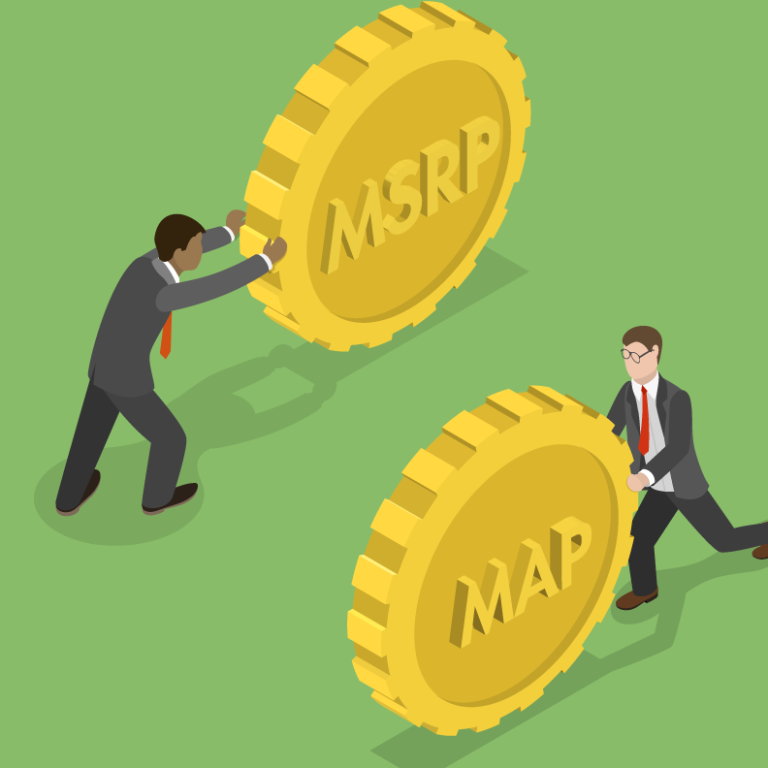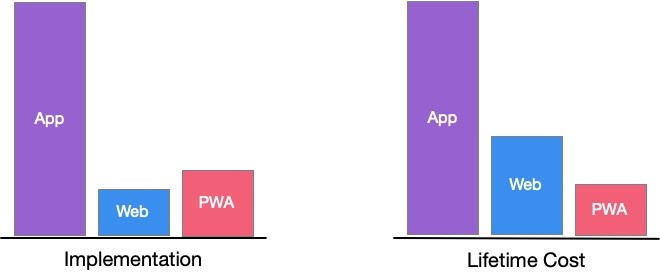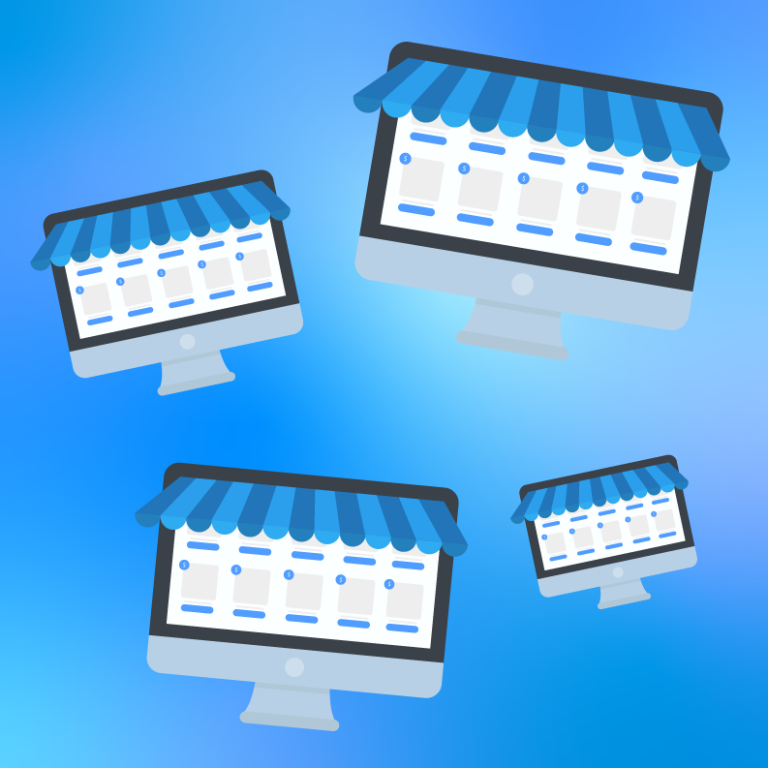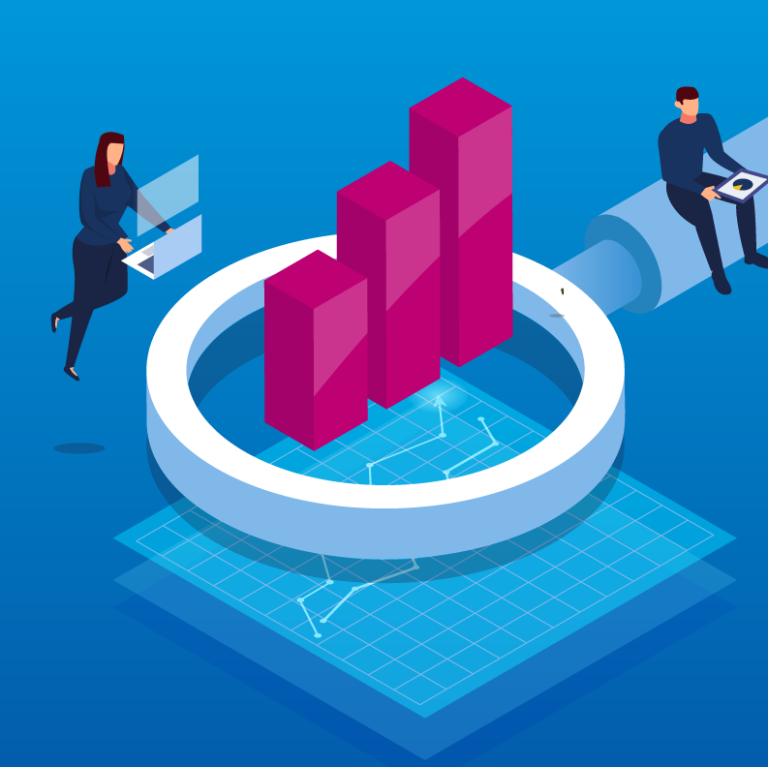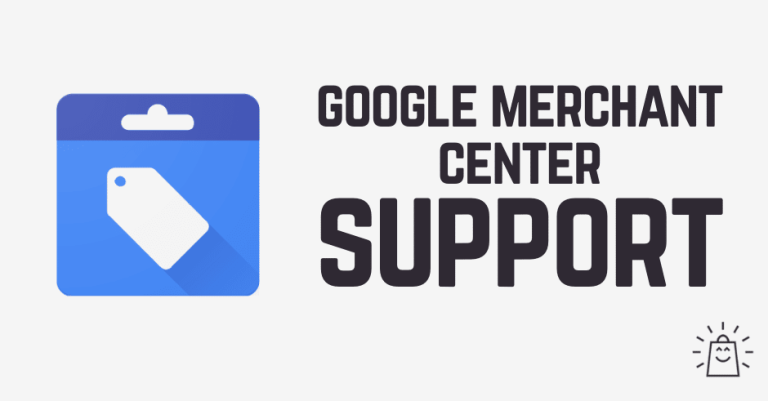Your eCommerce sales funnel, and how it’s set up, can make or break your business. The secret to its success is putting yourself in the minds of your shoppers and finding just the right points (touchpoints) where you can either engage them into a sale or move them along the buying journey.
The thing is, even if you think you have a customer-centric marketing strategy that is bringing in sales, you could still be missing out on increasing retention and profits at every stage. And even the slightest tweak at any of the stages on your eCommerce sales funnel could affect ROAS and long-term profitability.
In this post, we will cover the six stages of a well-performing eCommerce sales funnel and give tips on building and optimizing each step to maximize ROAS — answering these four key questions:
Everything You Need to Know about eCommerce Sales Funnels
If you want to jump ahead to a specific stage, feel free to click the links above. Otherwise, grab that coffee, and let’s get started.
What Is an eCommerce Sales Funnel and Why Is It Vital?
An eCommerce sales funnel is made up of various engagement points at different stages of a buying journey. Or, to put it another way, it’s how an eCommerce brand visualizes the overall journey of their shoppers and how they plan to attract, build, and maintain buying intent through this journey and beyond conversion.
A well-mapped eCommerce sales or conversion funnel will start at the first moment a potential customer becomes aware of a brand’s or a store’s products and continue until they become a loyal repeat customer or brand advocate.
There are three main parts of a well-performing sales funnel.
eCommerce Sales Funnel Parts
- ToFu (top of the funnel). This is where potential shoppers are discovering your brand or a product for the first time and are more than likely not interested in buying just yet.
- MoFu (middle of the funnel). These are potential shoppers who have seen an ad or visited your store at least once. They know who you are or what you’re selling.
- BoFu (bottom of the funnel). These are potential shoppers (and retargeted existing customers) who are ready and waiting to buy.
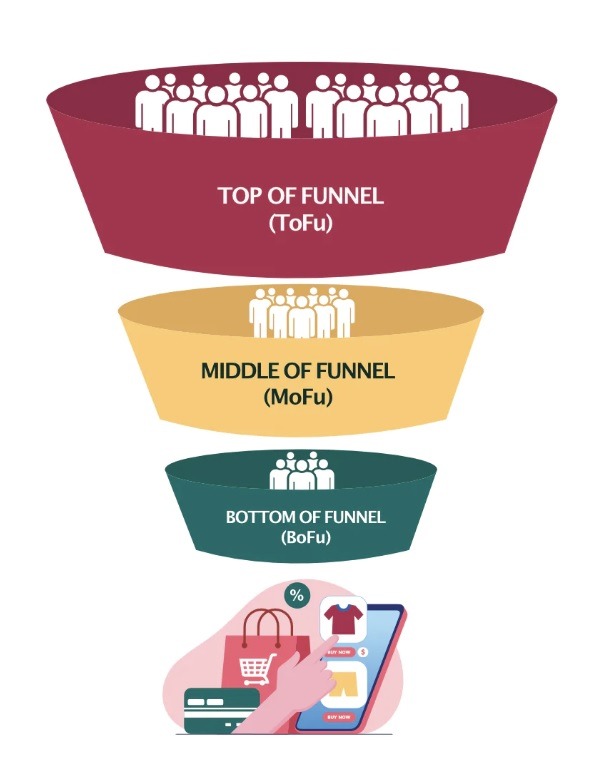
[Source: Shopify]
Of course, you shouldn’t have only one sales funnel.
Online retailer brands should create sales funnels for their brand as a whole, any new market segment they are trying to dominate, their categories or collection as a whole, and even for individual products (think new product launch strategies).
While some of your customers may run through this sales funnel quickly, others will need a lot more coaxing, depending on the intent of that first engagement or ultimate desire.
This can seem never-ending, but it’s a very vital process. And even if your average sales journey is quick, your buying journey doesn’t stop there. We know that if your goal is long-term growth and profitability with good ROAS, long-term retention strategies are pivotal.
Quick Note on Buyer Journey Mapping
An eCommerce buying journey is the path a buyer takes through your brand or product sales funnel and through its different stages. The map shows the points along this path where you engage with shoppers and move them along the eCommerce funnel. These are called digital touchpoints.
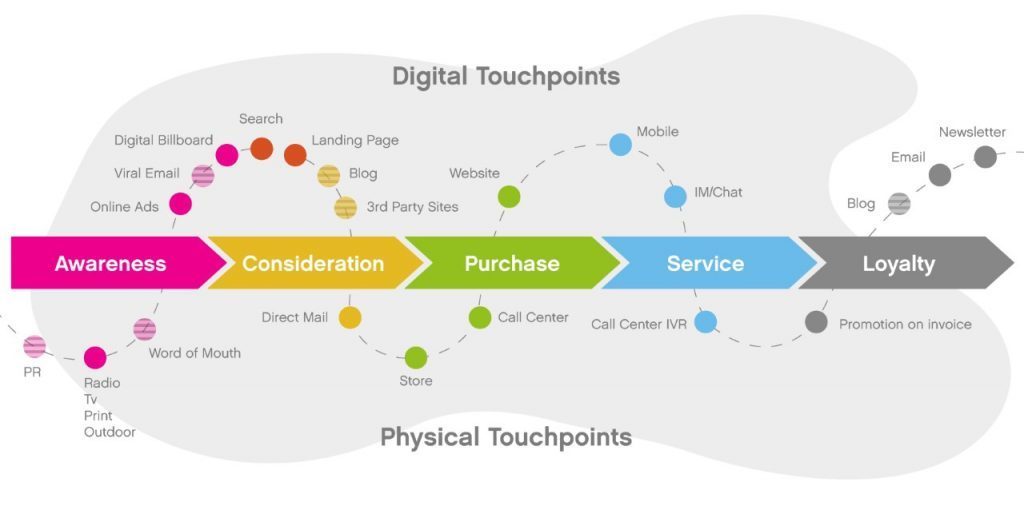
[Source: Do Good Things]
Ultimately, understanding your eCommerce marketing funnel — and how to optimize it — will ensure that you can strategically map the buying journey while improving your store’s overall ROAS.
What Are the Top Benefits of a Sales Funnel?
A well-performing eCommerce sales funnel:
- Streamlines marketing strategies, especially when combined with automation and machine learning
- Helps target the right shopper at the right time to improve overall ROAS
- Turns first-time leads into loyal, repeat customers
- Increases your overall conversion rates consistently
- Attracts new potential shoppers while re-engaging existing customers to new collections or products
The bottom line is that when combined with a well-functioning marketing strategy and eCommerce automation, your sales funnel, whether for a single product or your entire brand, will continuously attract, engage, and convert shoppers needed for long-term growth.
Now that we know the why, let’s look at the how.
How to Build Your eCommerce Sales Funnel the Right Way
To build a successful eCommerce sales funnel, you need to make sure you have strategies in place that engage with your potential shoppers (and existing customers) through all six critical stages of any sales funnel.
The goal is to ensure that you are engaging your audience at various touchpoints along each of these stages to either:
- elicit a sale
- or move them further down the funnel
Let’s take a quick look into each of these stages as they specifically pertain to online retail. We will also look at some of the mechanisms or channels online retailers can use to ensure they are engaging audiences at every one of these sales funnel stages.
1. eCommerce Awareness Stage
The first stage of any eCommerce sales funnel is about driving awareness. This ToFu stage is where a potential customer becomes aware of your store or products, or an existing customer may first become aware of a new product.
At this stage, your targeted audience is looking for information or an answer to a particular topic. Or they are looking for answers to solve a specific problem or need.
Either way, your goal here is to introduce your brand or product and/or offer your brand or product as a solution to their specific needs.
The eCommerce awareness stage usually happens off-site on the following channels:
- Search (SEO)
- PPC marketing
- eCommerce social proof and marketing
- Influencer campaigns
- Video marketing and product videos
2. eCommerce Interest Stage
By the interest stage of your sales funnel, your audience is now familiar with your store and the types of products that you sell. However, they still need more content or incentive to help encourage more brand/product interest.
It helps to think of this stage as the bridge between the ToFu and MoFu parts of your sales funnel.
At the eCommerce interest stage, your desired audience should be encouraged to research your products or brand more. This means browsing your site, reading reviews, and reaching out or engaging back with marketing or through support channels.
Therefore, your main aim at this stage is to connect without being too aggressive or hard sell — especially when targeting much newer audiences who haven’t bought from you before.
- Search (remarketing)
- Content marketing and blog (SEO)
- PPC marketing
- Video marketing and product videos
- Social media marketing
- On-site promotions and banners
- Email marketing
- eCommerce landing pages
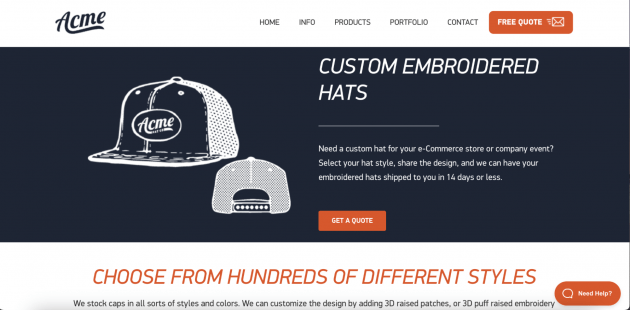
[Source: StoreYa Blog]
3. eCommerce Decision Stage
The next sales funnel stage is decision, which falls into both MoFu and BoFu.
At this stage, you’re targeting and engaging with warm, new potential customers, or existing customers who are already very familiar with your brand. They may just not be 100% convinced yet to buy for the first time, or they need to be introduced to a new product collection or a current promotion you’re running.
All engagements, or touchpoints, for this MoFu stage should be aimed at helping a prospective customer make a decision. Therefore, you have much more room to compel a sale with a well-timed deal or persuasive copy.
The eCommerce decision stage usually happens both on- and off-site through the following channels:
- Email marketing
- Landing pages
- Intent-based campaigns, such as Google Shopping
- Social proof
- Promotion campaigns
- On-site merchandising
But of course, don’t underestimate how important your overall store and brand shopping experience goes to pushing them to the next stage, action. If they haven’t had a smooth shopping journey up to this point, your promotions or more hands-on marketing tactic won’t be as effective.
5. eCommerce Retention Stage
According to Shopify, the average repeat customer rates should be around 28% for online stores. And when it comes to ROAS, this stage and those statistics are critical.
Why?
Because retaining customers requires a lot less budget than finding brand new ones, and repeat or loyal customers will probably generate just under 50% of a store’s total yearly revenue.
In short, it’s easier and cheaper to convert existing customers.
This is where the retention stage comes in. Although it starts much earlier, your post-sales customer service plays a significant role in ensuring customers shop from your store again.
Within the retention phase of your eCommerce marketing funnel, all your engagement should be aimed at bringing customers back to your store. And you will want engagements at this stage to be as automatic as possible.
This means creating a steady stream of remarketed traffic through a host of channels by targeting audiences who have already purchased from your store at least once.
The eCommerce retention stage usually happens both on- and off-site on the following channels:
- Email marketing
- Review and survey incentives (UGC)
- Strategic promotions
- Referral marketing programs
6. eCommerce Loyalty Stage
Also known as the advocacy stage, the loyalty stage is where you turn customers into fans. It is the final step in a high-performing eCommerce sales funnel. However, all your marketing and shopping experience, from the top of your sales funnel to this point, will contribute to the success of this stage.
In short, it’s about continuously providing good products, shopping experiences, and value, while rewarding repeat customers. At this stage, you want to encourage previous customers to spread the word about your brand and/or offer a little giveback, such as with a personalized birthday gift or VIP promotion.
The added benefit of this stage — and the personal recommendations that come with it — is more reach to new potential customers who already have a sense of trust.
The eCommerce loyalty stage usually happens both on- and off-site through all marketing channels. However, it’s loyalty programs that tend to be the most successful here. Chubbies is an excellent example of a brand that takes this to the next level.
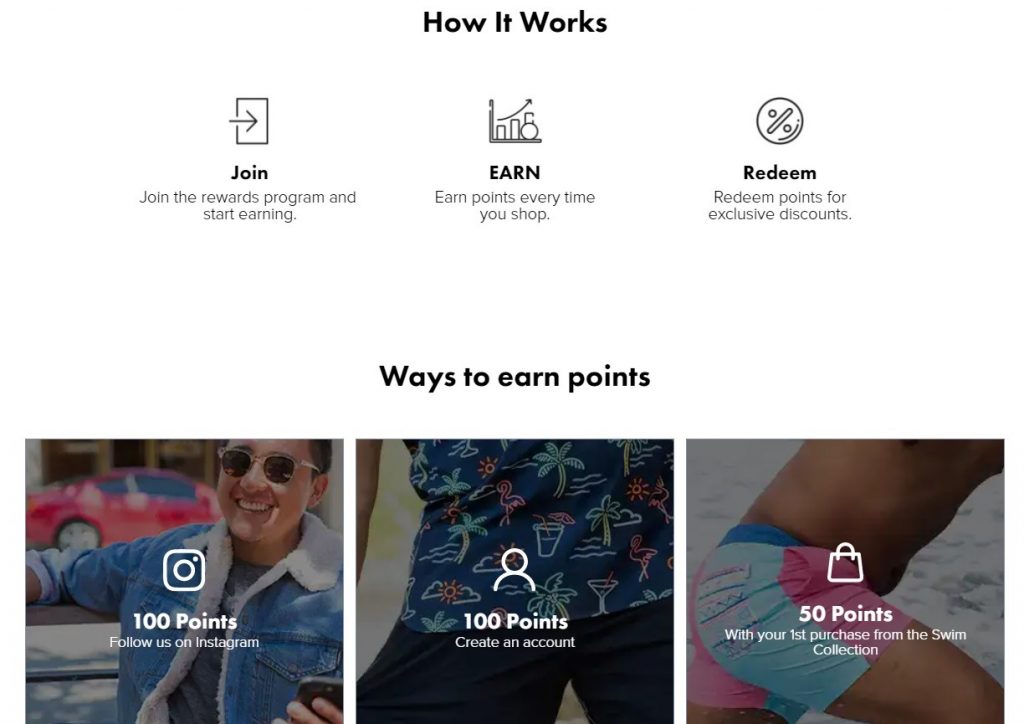
[Source: StoreYa eCommerce Blog]
This brings us to the next section in this eCommerce sales funnel guide: how to optimize to peak performance.
How to Optimize an eCommerce Sales Funnel for Max Performance [+Winning Strategies]
Whether you’re creating a sales funnel for a new product or you want to revamp your store brand’s overall sales funnel, the goal is not just to maximize sales, but to do so for the least amount of spend.
Why? Because sustained ROAS and growth mean sustained profitability.
Therefore, even the most minor strategy tweak matters. And, every aspect of your store, from your off-site marketing to your on-site navigation and optimization, must all work together to streamline your sales funnels and ensure their success at every stage.
The complication? There is no one-size-fits-all approach. Like with every aspect of your growing business, everything should be tailored to your brand, products, audience, and niche — testing and tweaking to optimize.
Having said that, there are some essential suggestions we can offer on how you can better optimize your eCommerce sales funnels. We also provide ideas on strategies you can use for each that have worked for us and our 400,000+ merchants.
We will do this by highlighting the important stages of a successful eCommerce sales funnel and breaking down stage strategies, as follows:
- Awareness stage strategies and optimization tips
- Interest stage strategies and optimization tips
- Decision stage strategies and optimization tips
- Action/purchase stage strategies and optimization tips
- Retention stage strategies and optimization tips
- Loyalty stage strategies and optimization tips
Let’s jump in.
1. Awareness Stage Strategies and Optimization
To ensure that your awareness marketing strategies are a success, you need to do two things:
- Reach potential shoppers and new audiences who are interested in the products you’re selling
- Engage these audiences further down into your sales funnel
The trick is focusing on the right audience.
There are, of course, several different platforms and channels you can use, depending on where your desired target audience hangs out. However, when it comes to eCommerce, there are some foundational channels and strategies every store should be testing.
Here are our top awareness marketing suggestions for ToFu advertising.
Drive a Steady Stream of Targeted Traffic with Facebook Ads
From lookalike audiences and interest-based targeting to remarketing (to introduce previous traffic to new product launches), Facebook drives awareness in a big way while also bringing targeted traffic to your store.
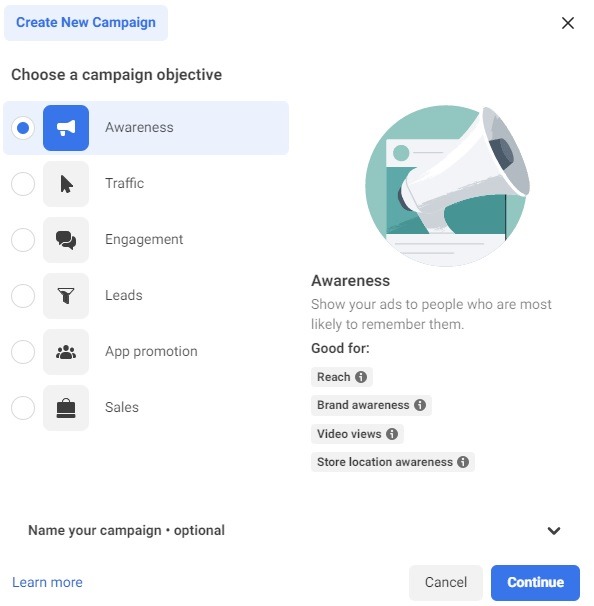
Some top strategies to do just that include:
- Using Facebook to drive traffic to high-value blog content
- Focusing your Facebook ad messaging around a clear value proposition of your brand and/or product
- Using social proof and other UGC to instantly build trust with new audiences
- Incorporating Facebook automation with Dynamic Ads
- Taking advantage of the power of product video engagement and reach
- Using your existing customer data (such as email lists, engagement lists, and converted customers) to build lookalike audiences to target new, similar potential shoppers
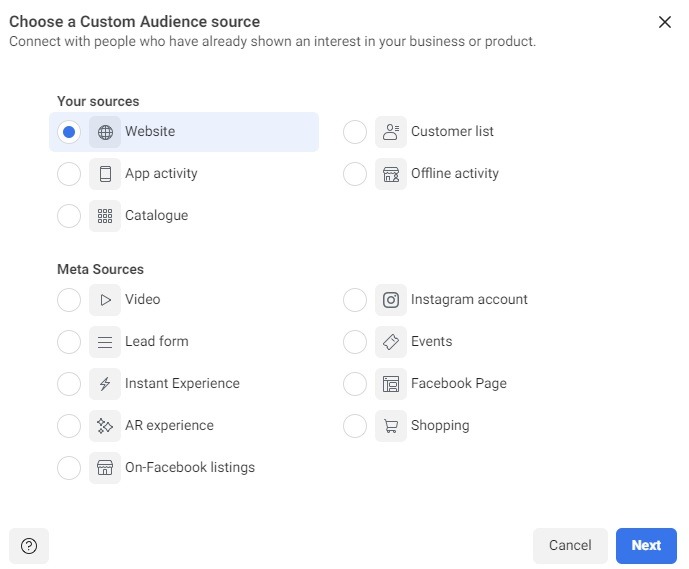
Take Advantage of High-Intent Search Engines
Another important ToFu marketing must is search engines — specifically, search marketing platforms that tap into high-intent traffic, such as Google Ads for eCommerce.
Bottom line: Every store should be investing heavily in Google Search and Shopping ads to drive awareness and traffic at once.
Why?
Because Google offers reach to brand new audiences who are already actively searching for what you’re offering — especially Google Shopping. Actually, as you may know, Google Shopping provides some of the best ROAS.
There are various ways you can use Search to drive awareness; here are some of our top strategy recommendations:
- Bid on competitor brand name terms, while ensuring you invest in your own branded keywords
- Make sure you’re highlighting your brand value proposition and focusing on building authority in your ads
- Test Google’s similar segments to target audiences with similar needs to your existing customers
- Dominate SERP pages by investing in good quality content and PPC campaigns for the same search terms
Bonus Tip: Harnessing the Power of PPC for eCommerce Sales Funnel Performance
When it comes to driving brand or product awareness, social media channels can be compelling. Channels such as eCommerce Facebook, Instagram, and, more newly, TikTok, offer interest- and trend-based advertising and content marketing for brands — driving a steady form of new audiences.
However, it’s combining social media with other vital digital channels into a robust marketing strategy across all your funnel stages that really makes the difference. This can, of course, be done manually, but to compete with growing eCommerce competition, you may want to consider advanced automation and machine learning. This is where Traffic Booster comes in.
[embedded content]
Find Out More
Referral programs are a great way to reward repeat customers while simultaneously boosting exposure to new potential customers.
Additionally, as these new potential customers are hearing about your store or products from a source they trust, it’s likely they will move through your sales funnel a lot quicker. Think lower quantity, higher quality.
ReferralCandy suggests the two-sided incentive approach: offering rewards to both parties. Here are some more tips they offer on creating a high-performing eCommerce referral program that grows consistently:
- Be as generous as you can with friend offers
- Consider allowing non-customers or new potential shoppers to get the same benefits for referring a friend
- Be quick to inform new customers about your referral rewards program
- Upsell referral programs on your store
- Be transparent with referral rewards terms and conditions
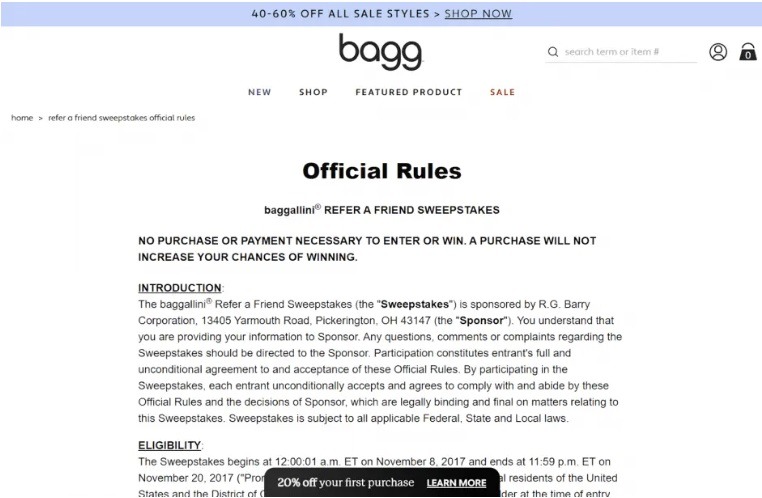
[Source: ReferralCandy]
2. Interest Stage Strategies and Optimization
As we highlighted earlier, your goal for interest stage marketing should be to engage with your audiences to further build trust — and interest — with potential shoppers.
During this timeline of your sales funnel is where you start to introduce dynamic personalization, remarketing lists, email sign-up campaigns, and more. All of these are designed to build trust and move potential shoppers further into your product or brand funnels.
Let’s look at some interest-building strategies and tips that will help do just that, while also ensuring you are optimizing for marketing ROAS.
Dedicate Time and Budget to Social Proof
Social proof is a popular way to build brand and/or product trust and authority within interest-building marketing strategies.
Why?
Whether it’s on-site reviews and testimonials or Google Shopping displayed ratings, displayed customer opinions will help give interested audiences more peace of mind. This means that collecting and displaying as much social proof as possible is vital. To do that, you will need to invest the time, effort, and, of course, budget, to ensure you have the right tools.
Ultimately, you want to ensure you can display social proof on the following channels:
- Digital paid ads
- Email marketing
- Store and product pages
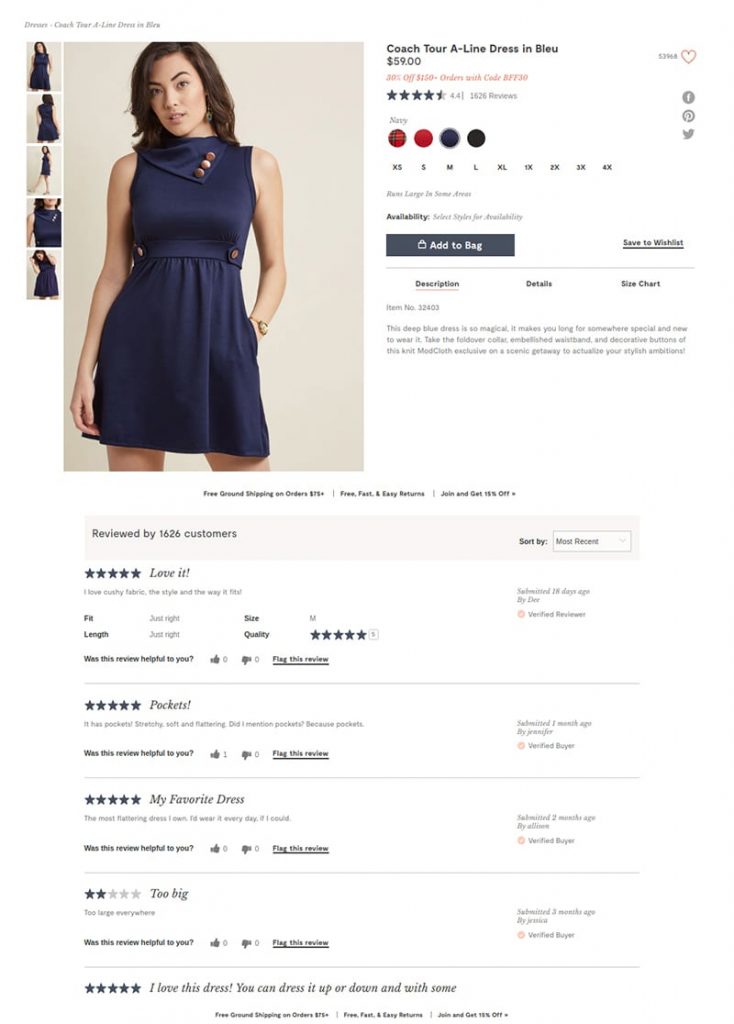
[Source: Smart Insights]
You can visit our complete eCommerce Social Proof guide for a more in-depth look at top social proof strategies.
Encourage UGC (User-Generated Content)
UGC plays a big role in brand-building and shopping experiences. While showcasing your product in a real-world context, UGC collection enables happy customers to engage almost directly with the audiences you are targeting during the interest stage of your sales funnel.
While customer reviews and ratings do fall under UGC, UGC encompasses more than that. UGC can include:
- Reviews and testimonials
- Guest post content
- Social media content
- Influencer marketing
- Live streams
- Customer forums and groups
- Case studies
- Video content
- Hashtag campaigns
- Surveys
- On- and off-site events
Regardless of what type you use, authenticity is critical. A brand who understands that well is the active and athleisure brand Outdoor Voices. Using their #doingthings campaigns, they feature customers capturing themselves being active and having fun using their products.
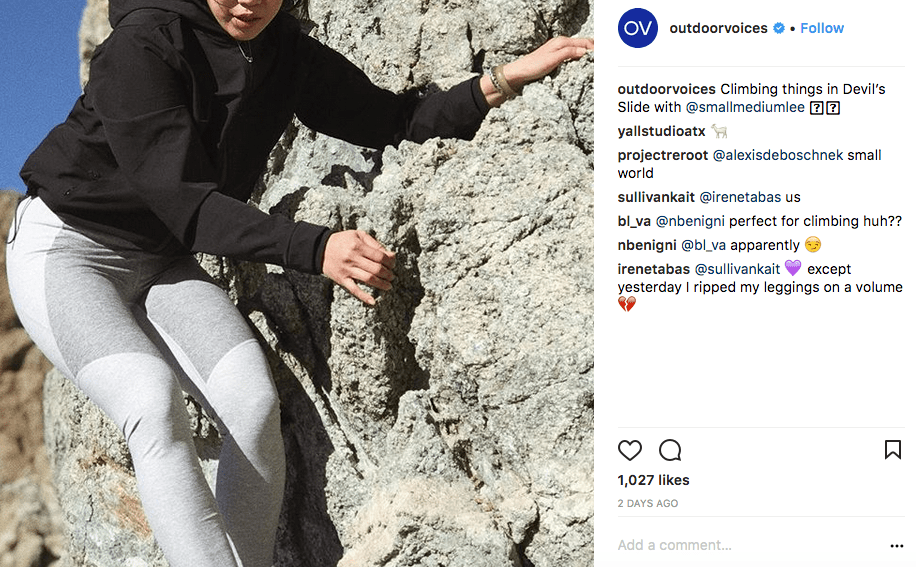
[Source: Sellbrite]
Invest Heavily in Optimized Customer Service
Your customer service plays an essential role at each stage in order to move potential customers down the sales funnel. So yes, optimizing and improving your customer support should be a key strategy for all three parts — ToFu, MoFu, and BoFu.
As we know, this is to ensure that any brand or product questions, which could cause funnel friction or stalling, can be addressed as quickly as possible.
However, your customer support/service is most important when moving your potential shoppers from mildly interested to seriously deciding.
If your brand is reachable, transparent, and responsive their most burning brand or product questions, you not only help alleviate any “on-the-fence” issues they may have, but also increase brand trust.
So, how can you optimize your eCommerce customer service? Here are a few strategies to get you started:
- Display important pages. Make sure your terms and conditions and FAQ pages are easy to find, easy to navigate, and easy to understand.
- Meet customers where they are. Whether it’s on-site or on external channels (such as Facebook), make sure your support can answer the customer’s questions on their desired platform.
- Continuously measure and optimize your support strategies. Every customer service support system should be monitored and regularly tweaked as market or brand conditions change.
- Invest in automation and personalization. Making support engagements as quick and as personalized as possible goes a long way to moving potential customers to checkout pages.
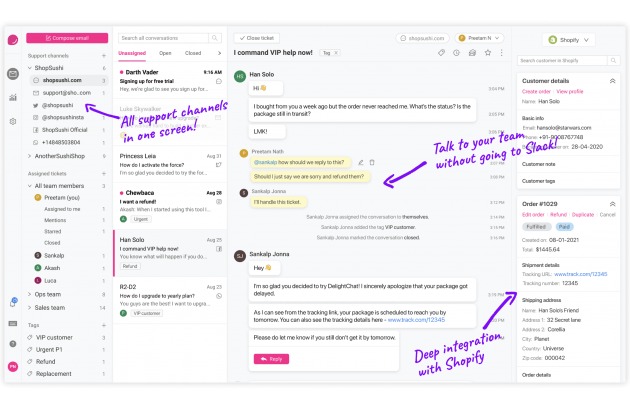
[Source: StoreYa Blog]
You can read more about these and other top tips in our 6 Actionable Tips to Upgrade Your eCommerce Customer Service Strategy post.
3. Decision Stage Strategies and Optimization
As we highlighted earlier, the decision stage is where potential customers and existing customers have come to know about a new product, your brand, or collection. They just need that extra push to move from the MoFu to the BoFu.
This is where your decision-stage strategies come into play. Here, you are targeting potential shoppers in your funnel who have higher buying intent but may still have one or two questions about the product they are thinking about. Or, they are waiting for a well-timed promotion.
Here are our top decision marketing suggestions for BoFu advertising.
Reduce Store Shopping Experience Friction
We know that a vital component of your overall sales funnel and buying journey is your online store itself. You can have the best products in the world, but if they are hard to find or buy, potential shoppers will move on to your competitors.
At the decision stage, this is even more important. The more friction there is between deciding and action (buying), the more likely a potential buyer may change their mind at the last minute.
Ultimately, you want to ensure that there is a seamless flow from your off-site marketing to your store, from your store to your product pages, and from your product pages through to your checkout process. This means optimizing your:
- Shopping experience
- Store trustworthiness
- Technical performance
- Marketing
So, how do you know where you have room to tweak? You can assess all of these things in minutes, for free, with the Benchmark Hero eCommerce store audit tool.
[embedded content]
Find Out More
Boost Your Product Email Marketing
Another powerful eCommerce marketing tool that helps engage potential shoppers from decision to action is your email marketing. Not only are your email lists full of quality leads very familiar with your brand, but with the right segmentation, you can tap into groups who are the readiest to buy.
A well-timed promotional campaign, for instance, to shoppers who have been actively reviewing those products can quickly turn decisions into sales. Here are some other top decision-stage email marketing channels:
- Educational content, tutorials, and exclusive webinars
- Live Q&A sessions or demos
- Discount codes and time-based offers
- Personalized product recommendations
- Wishlist reminders
No matter what types of emails you create, you want to ensure they have the following elements:
- A strong CTA (call-to-action)
- Trust signals, such as ratings, reviews, star ratings, etc.
- Key product/shipping/deal information
And they don’t have to be overly complicated. Here’s an example of a decision-stage email that has all three.

[Source: Hubspot]
Here’s another example, from Adidas, that combines a strong CTA to remind shoppers of the benefits of checking out — in this case, free shipping.
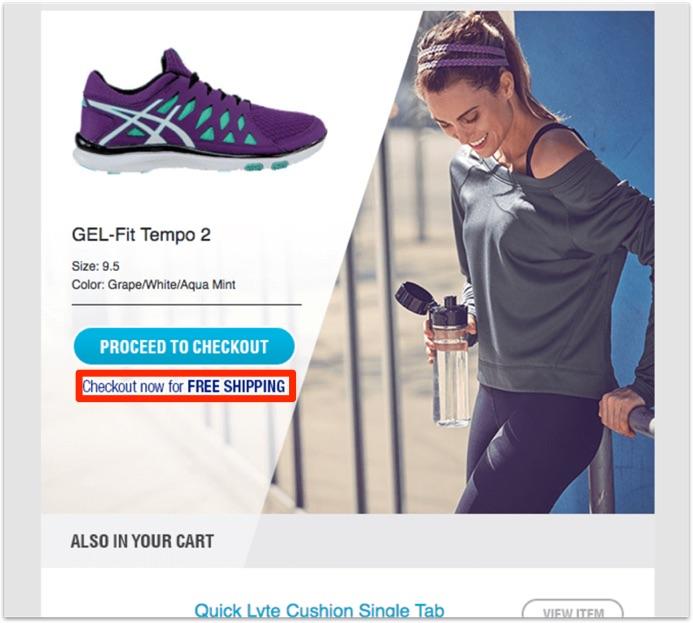
[Source: Neil Patel]
Overhaul Your Product Pages
Your product pages play a key role in both your MoFu and BoFu marketing. Not only does it help attract shoppers through SEO, but it keeps potential customers interested and engaged while moving them through the decision to action stages. Think of product pages as the final bridge between decision and action.
A well-performing product page is:
- Designed for customer ease of use
- Optimized for humans and bots
- Built to showcase product features
- Set up to include benefit-driven product descriptions
An excellent example of a well-designed page comes from online retailer UNIQLO. As you can see in their display below, they are able to give a lot of information without displays being overcrowded. They also make use of simple yet effective product video displays.
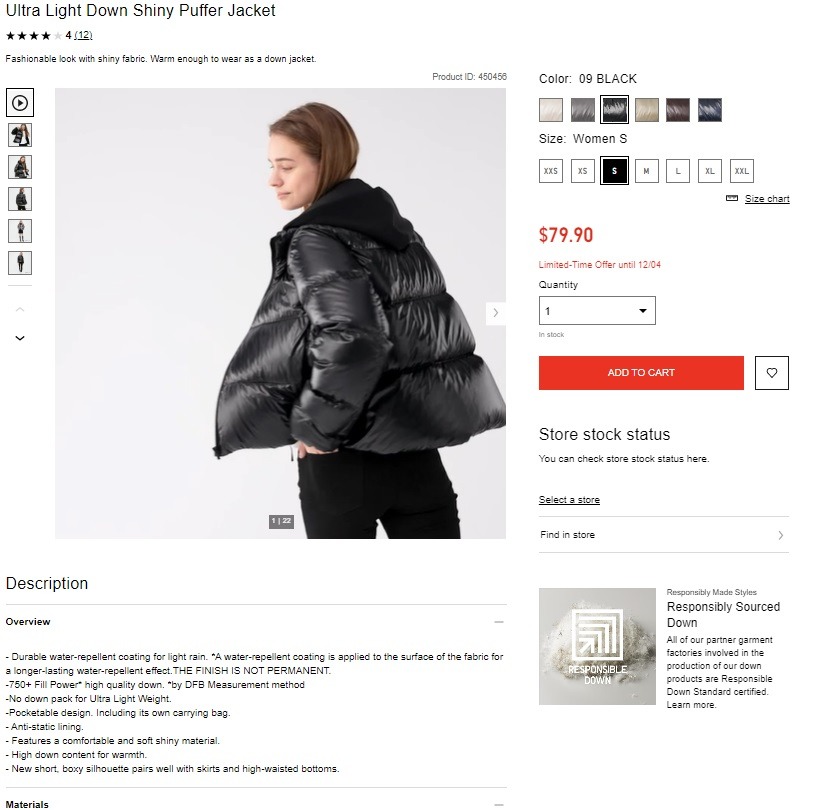
[Source: UNIQLO]
4. Action/Purchase Strategies and Optimization
Your action strategies will happen mostly on-site or center around cart optimization. Here the shoppers have gone from interested to keen and are now at the bottom of your sales funnel. They are primed and ready to buy. Therefore, your strategies here are to:
- Make the buying process as seamless as possible
- Remind shoppers of product value
- Upsell or cross-sell (where relevant)
- Remain transparent about product and shipping details
Let’s look at some top strategies and optimization tips for doing just that during your sales funnel action stage.
Power Action with AOV Strategy Upgrades
During the action stage, your audiences have the highest possible intent when compared to other stages of your sales funnel. Capitalizing on this intent can help boost conversions and AOVs (average order values) in a big way.
Although you want to start these strategies at the previous stages — using tactics such as a minimum shipping threshold or BOGO (buy one, get one) banner promotions — it’s during the action stage that you can give these a big boost.
A good way to do this is by displaying these thresholds in the cart and checkout.
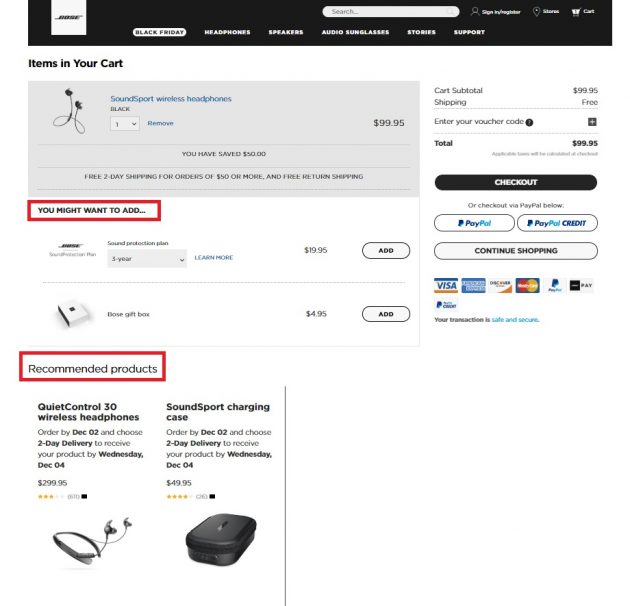
[Source: Checkout Optimization Hacks]
This kind of up- and cross-selling can be easily implemented with the right apps/tools. Even better if you combine it with personalization. Ultimately, you want to base recommendations on each specific shopper’s site behavior.
Here are some action stage AOV optimization strategies and tips to get you started:
- Highlight your minimum thresholds for free-shipping incentives on store, product, and cart pages
- Offer bundled deal upsells in your cart
- Include discounted upsells as incentives when an order is confirmed but before final checkout.
- Offer additional incentives in your on- and off-site abandoned cart marketing
- Cross-sell related products, styles, categories, and/or varieties during checkout flows
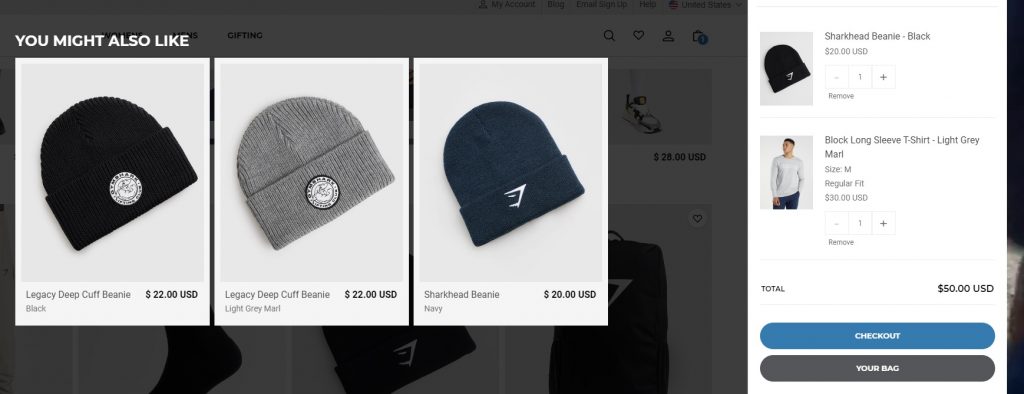
[Source: Gymshark]
Eliminate Any Checkout Bottlenecks
Creating a friction-free checkout experience is vital in holding these shoppers’ attention long enough for the final checkout button. To do this, you want to ensure you continuously look for any bottlenecks and eliminate them quickly.
This means making sure that there are:
- As smooth as possible shopping experiences, including back buttons
- No surprises or hidden costs after checkout has begun
- Limited fields and pages, ensuring checkout is as uncomplicated as possible
- As many payment options as possible
For more tips on optimizing and streamlining your cart and checkout flows, visit our full Cart and Checkout Optimization guide.
5. Retention Stage Strategies and Optimization
Just because a sale is done, doesn’t mean your shoppers’ journey is done. In fact, this is one of the most critical stages in your sales funnel, as it gives eCommerce stores the opportunity to continue to engage with new customers.
A good post-sale retention strategy will help you build long-term revenue growth and improve AOVs, increase your store’s overall conversion rates, and drive reach (through UGC and referral programs). It will also:
- Improve your shopper’s overall experience
- Lower your acquisition costs
- Improve your LTVs (lifetime values)
Here are some of the top retention stage strategies you can use to optimize your sales funnel and buying journey.
Overestimate the Value of After-Sales Service
Never underestimate the power of post-sales service. You can have the best marketing strategies and incentives in place, but if a shopper’s experience wasn’t great, they will not bite. It also goes a long way to not just retention, but long-term loyalty.
In short, good after-sales eCommerce service will help you:
- Strengthen and fortify your store brand image
- Build stronger, longer-lasting relationships with customers
- Increase a shopper’s lifetime value
- Improve your chances of collecting positive reviews and feedback
All of these lead to higher shopper satisfaction, repeat sales, word-of-mouth marketing, and brand loyalty. Here are some after-sales tips and strategies to get you started:
- Resolve any issues that come up after purchase as quickly as possible and keep communication open
- Allow for returns, exchanges, and warranties, while ensuring the systems make it easy for shoppers
- Make sure your customer service teams are available and communicative
- Keep customers informed about their purchases and shipments along the way
- Go the extra mile with post-sale email confirmations

[Source: Shopify]
You also want to elicit honest feedback that you can use for improvement while giving you a chance to directly address any issues a customer has. This is where feedback, reviews, and referral programs come in.
Encourage Feedback, Reviews, and Referral Sign-Ups
According to studies, referral marketing can generate up to 5X higher conversion rates than other marketing. And when you combine that with the fact that 90%+ of consumers trust recommendations from people they know — there is zero doubt on just how important after-sales referral marketing triggers can be.
The perfect time in your sales funnel to encourage this feedback is after a smooth shopping experience after a customer has received their product. This offers an opportunity to re-engage with new shoppers and helps elicit more responses or referral sign-ups.
The overall aim here is to:
- Encourage and collect UGC — which can be used to attract new customers and boost sales in on- and off-site marketing
- Re-engage new customers with incentives to turn once-off shoppers into repeat customers
- Boost word-of-mouth marketing with referral marketing
Here’s an example of an online store having a lot of success with referral marketing: Gilt — an online store that sells designer clothing at a discount.
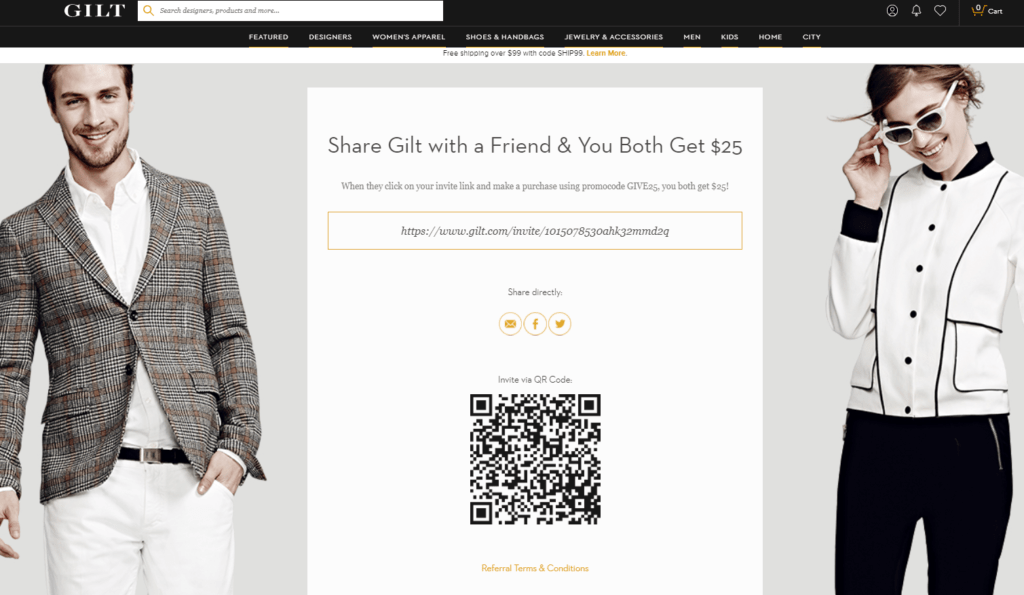
[Source: Rewardful]
Here are some basic must-dos for your marketing teams to help your brand build a high-performing, post-sale referral marketing plan:
- Aim to always provide fantastic customer service
- Build and implement a robust referral program
- Make sure a shopper’s product experience is shareable (think, unboxing upgrades)
- Consider integrating influencer marketing in your sales funnel
- Use hyper-segmentation to make referral marketing, such as emails, more personalized
6. Loyalty Stage Strategies and Optimization
Last, but by no means least, let’s look at loyalty building. The final stage in any buying journey or sales funnel marketing strategy is the loyalty stage. This is where you turn once- or twice-off customers into fans — boosting long-term conversions, profits, and ROAS.
Even a well-thought-out thank you page can improve your customers’ brand impression, tenfold!
Everything that has led a shopper to this stage (your marketing, store, products, and shopping experience) play a big part in long-term loyalty. Or, as the industry puts it, it results in the three Rs of loyalty:
- Retention
- Related sales
- Referrals
Here are some top loyalty strategies for your overall eCommerce sales funnel.
Build a Robust Loyalty Program
The first port of call to ensure your eCommerce sales funnel strengthens long-term loyalty is building a loyalty program for your brand. With the right strategy in place, eCommerce brands can incentivize existing customers back into other product or category sales funnels.
To ensure your loyalty program is set up for success, you want to ensure that it:
- Closely aligns with your eCommerce brand
- Has been personalized to specific shoppers or segments
- Includes good-value incentives and some level of gamification
A winning eCommerce brand that masters all three of these elements is Chubbies.
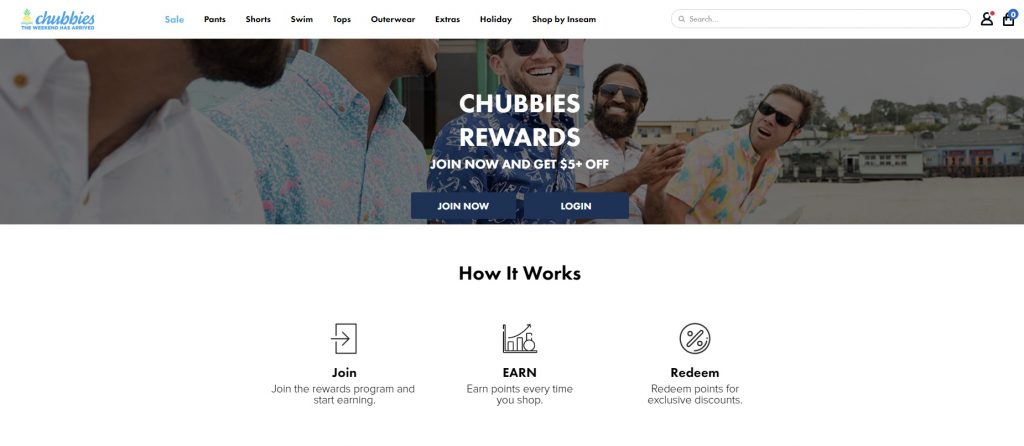
They combine loyalty with a rewards program where potential shoppers and existing customers have the opportunity to earn incentives. Here are some of the ways users can earn Cubbie points.
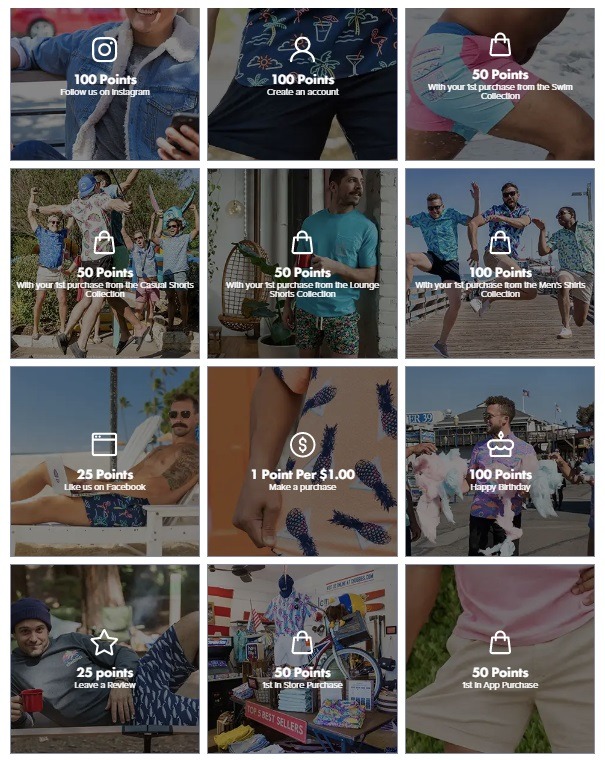
And the more points a shopper has, the better the deals!
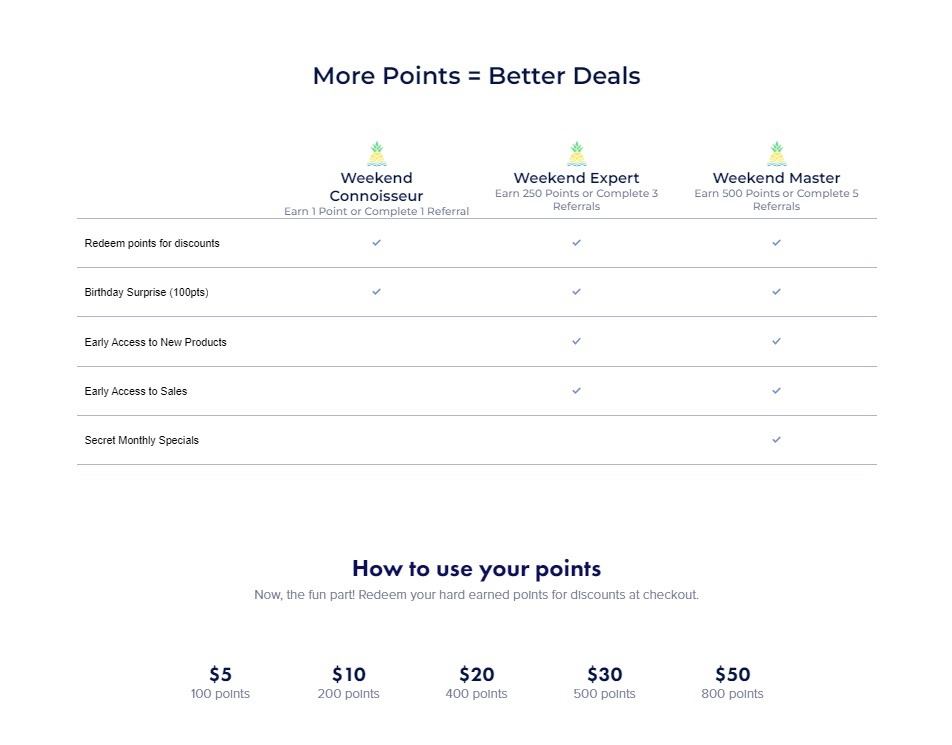
Keep Your Customers Engaged on a Regular Basis
Finally, don’t underestimate the power of ongoing engagement. Whether it’s a well-timed VIP promotion, congratulations for a milestone, or a new product launch email, retargeting repeat customers is a great way to build long-term loyalty.
Here are just a few tactics you can use at the very bottom of your sales funnel (BoFu) to re-engage customers back into earlier stages of the sales funnel while also boosting loyalty:
- Ask how your brand/product/shopping experience could improve by sending regular customer surveys
- Create a niche-related online community for your customers — this is something Beautiful Disaster has had an incredible amount of success with (you can read more here)
- Take advantage of retargeting digital marketing and automation
- Harness the power of email marketing segmentation to send personalized milestones, product recommendations, or promotional emails
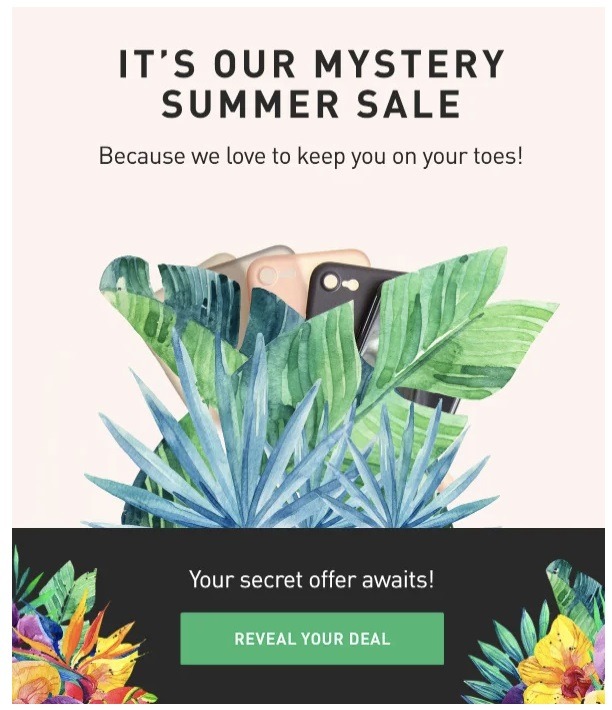
[Source: Reall Good Emails]
What Are the Key eCommerce Marketing Funnel Metrics to Keep an Eye On?
But how do you know all of these sales funnel strategies are truly optimized to peak performance? By keeping a close eye on important eCommerce marketing sales funnel metrics. You will find these in your store, Google Analytics, or channel metric reports.
Let’s look at the key metrics you should be looking at for each sales funnel part, including ToFu, MoFu, and BoFu, as well as retention and loyalty stage metrics.
Let’s take a closer look at each.
1. Top-of-the-Funnel Metrics
Also known as upper funnel metrics, these are marketing KPIs you want to closely monitor to ensure your sales funnel is providing the most amount of interactions possible. It also gives way to a wide collection of data that can be used to build buyer personas for new segments and build brand or product awareness.
Some of these essential upper funnel metrics include:
- Impressions. Sales funnel impressions are a simple yet important metric for measuring the success of awareness campaigns. Not only does it tell you the rate at which these campaigns are being seen, but when compared to CTCs, you can tell if the copy/targeting is lacking in turning views into clicks.
- Reach. While impressions tell you the number of times a campaign is seen, marketing reach metrics tell you the total number of users who have seen your campaign.
- Website traffic. One of the most critical metrics for ensuring your top-of-the-funnel marketing is successful is your store traffic — specifically, new sessions.
- Bounce rates. Your eCommerce bounce rates will tell you the number of potential shoppers you brought to your site who left without taking a single action. This can help point to relevant issues or problems with your campaign targeting. The higher your bounce rate, the worse your engagement rate is. This can point to holes in your sales funnel where you lose potential shoppers before moving them to the next stage.
- Average session time. While the bounce rate points to users who leave without engagement, your store’s session time will tell you how much time they spend on your campaign landing pages. If your sales funnel is performing well, average session times (average time spent on pages) will be higher — pointing to building brand/collection/product interest.
2. Middle-of-the-Funnel Metrics
Your MoFu tracking metrics are usually centered around broad marketing KPIs, concentrating on traffic and engagement. Some of these critical middle-of-the-funnel metrics include:
- Organic traffic. You’re looking for previously targeted new potential shoppers who come back to your store through high-value content. This helps you turn aware shoppers into interested shoppers. Therefore, the higher your organic search, the better.
- Engagement. You will want to track the number of shares or comments your social content is getting off-site. On-site, you want to look for metrics such as pages viewed or time spent on a page to see how potential customers are engaging with your store.
- Conversion rate per channel. You will want to review each of your top marketing channels to make sure that the conversion rates for these align with the goals you’ve set. This can be clicks, email sign-ups, landing page traffic, etc.
- CTRs (click-through rates). With regard to off-site marketing, CTRs are a key middle-of-the-funnel metric to watch. The idea is to increase your CTRs across all your channels so that you can engage them in the BoFu marketing on your site.
- Active subscribers. When it comes to the eCommerce sales funnel, email marketing plays a vital role in every stage. In terms of MoFu, building email marketing lists is vital in ensuring you can move potential customers from the middle- to bottom-of-the-funnel stages. Therefore, you want to keep a close watch on your active subscribers.
3. Bottom-of-the-Funnel Metrics
Also known as lower-funnel metrics, this data shows how your peak sales marketing is performing. Through interest and action stages, a sign of sales funnel success during BoFu marketing is the number of sales you are generating and their value.
- Entrances. A metric used specifically for sales funnels, entrances is the volume of potential shoppers who “enter” your sales funnel within a given timeframe. You want to know this metric to see how long a customer is in your funnel before they convert. The longer the time frame, the more time and budget you spend to convert the sale.
- Total sales. By measuring the total number of sales, you can gauge the overall success of your entire sales funnel. You want this number to be consistently climbing to ensure long-term growth. For instance, if you have a high conversion rate but a low total sales, this can point to missed opportunities in your sales funnel.
- AOVs. Next, you will want to review your average order values to ensure you aren’t just driving the right amount of sales but the most amount of spend per sale. This will ensure you are optimized for ROAS while building long-term profitability.
- CPA (cost per acquisition). It’s not enough that BoFu strategies are converting; they need to be doing so at optimum CPAs. Otherwise, you’ll be spending all your profits before a sale has even been completed. CPA will enable you to track and measure how much budget is going to acquire new customers — and point to areas in your overall sales funnel that should be tweaked.
- Conversion rates. The most common sales funnel metric is your conversion rates. Not just in terms of store conversion, but marketing conversions as well. This will help you assess your overall sales funnel — whether for channel, product, category, or brand — and see where there is improvement potential.
4. Retention and Loyalty Metrics
Lastly, you will want to measure your rental and loyalty stage metrics to ensure they are performing at their optimum. Let’s take a look at some of the top eCommerce sales funnel metrics for doing just that:
- LTV (customer lifetime value). To assess the continuous value of a customer, you will want to keep a close eye on your LTVs. These marketing funnel metrics point to an average estimate of the revenue a customer will generate over time.
- Customer churn. eCommerce customer churn is an important retention metric and refers to the number of customers churned/turned over in a given period. This metric will help you determine the number of customers lost. Simply put, the lower your churn rate, the better your retention strategies work.
- Repeat purchase rate. Another metric that points to the success of your retention and loyalty strategies is your repeat purchase rates. This metric will show you the ratio of shoppers who have made more than one purchase on your store compared to your total number of customers.
- Upsell ratio. Your store’s upsell ratio is another good marketing funnel metric for assessing the success of your sales funnel loyalty strategies. Here you are tracking the total number of purchases that your shopper has made after their first initial product purchase.
Wrap Up
There you have it, everything you need to know to build a high-performing eCommerce sales funnel and the key strategies you should use to optimize it. To recap:
How to Optimize Your eCommerce Sales Funnel
Whether you’re building or optimizing a sales funnel for your entire brand or a new product you’re launching, there are three vital rules to follow: test, tweak, and optimize.
Ultimately, it’s about building a sales funnel that not only fits your end result but speaks directly to your desired audience. Also, it can’t be successful if you’re not investing heavily in your overall shopping experience and eCommerce marketing strategies, making sure they all work seamlessly together.
Here are some guides that will help you do the latter, ensuring you can build an eCommerce marketing funnel for each channel:

Still got questions? Post them in the comments section below!

Nicole Blanckenberg
Nicole is a content writer at StoreYa with over sixteen years experience and flair for storytelling. She runs on a healthy dose of caffeine and enthusiasm. When she’s not researching the next content trend or creating informative small business content, she’s an avid beachgoer, coffee shop junkie and hangs out on LinkedIn.
Comments
comments
Powered by Facebook Comments

